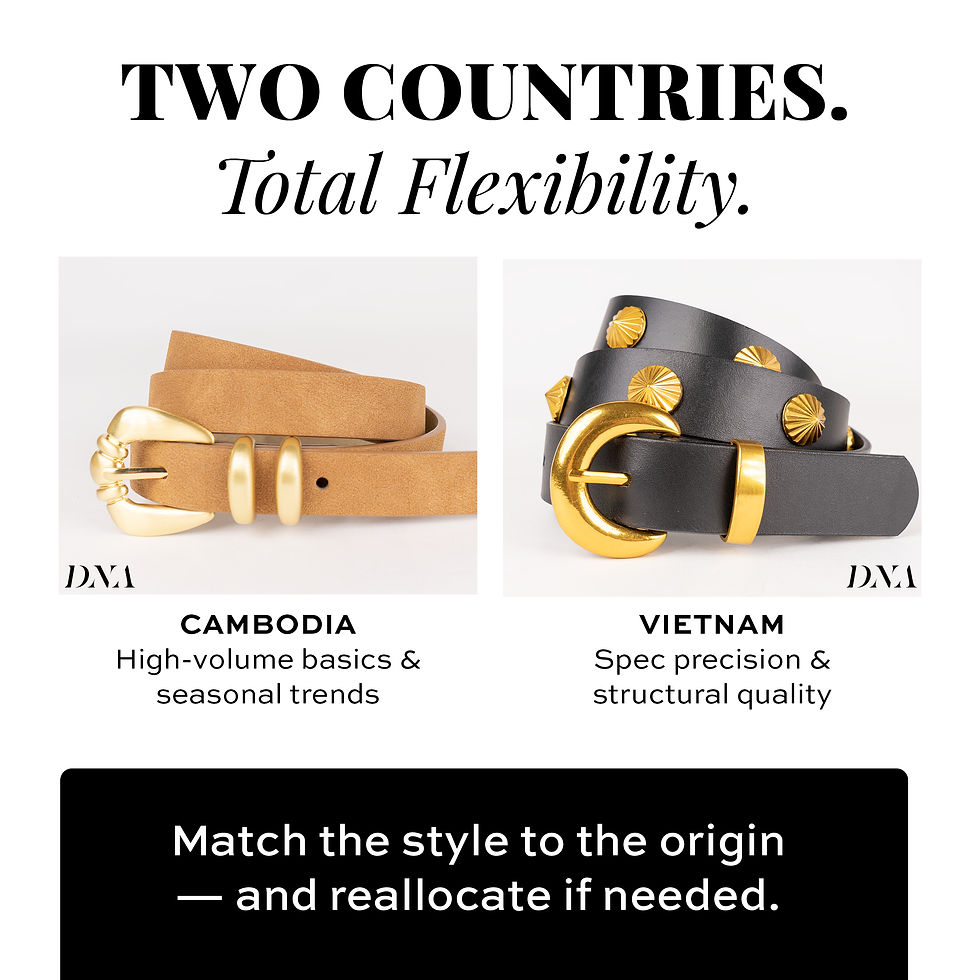Rethinking Belt Development: Why a Multi-Origin Sourcing Strategy Protects Your 2026 Buy
- DEZINE LAB
- Jul 15
- 2 min read
As retail buyers and sourcing teams begin planning their Spring/Summer 2026 accessory assortments, belts present a unique challenge—and opportunity. This fast-moving category is highly responsive to trend shifts and vulnerable to supply chain volatility. That’s why forward-thinking retailers are now embracing a multi-origin sourcing strategy for belts.
At Dezine News Accessories (DNA), we’ve built a sourcing model that protects both your timeline and your margin, ensuring your belt program stays agile, aligned, and always on trend.
The Risks of Single-Region Sourcing for Belts
Belt assortments—especially in private label—require precision. A single hold-up in raw materials, shipping, or approvals can throw off your delivery calendar and erode margin.
If you're sourcing belts from just one country, you're more exposed to:
Tariff hikes
Freight increases
Port congestion
Production bottlenecks
Last-minute rerouting costs
Given the tight timelines of fashion accessories, even one delay can ripple across your assortment. That’s why single-region sourcing puts your belt program at risk.

🧵 Cambodia: Ideal for high-volume basics and seasonal fashion belts with cost-effective, fast-turn capabilities. Think: puff details, novelty buckles, and tween trends.
🛠 Vietnam: Best for belts requiring spec precision and structural quality, such as firm-core PU styles, dimensional trims, or engineered stitching.
Our Solution: Two Countries, Total Flexibility
DNA has spent the last several years building an agile, multi-country production network specifically for belt development.
Here’s how we build flexibility into your assortment:
🧵 Cambodia: Ideal for high-volume basics and seasonal fashion belts with cost-effective, fast-turn capabilities. Think: puff details, novelty buckles, and tween trends.
🛠 Vietnam: Best for belts requiring spec precision and structural quality, such as firm-core PU styles, dimensional trims, or engineered stitching.
🔁 Built-In Reallocation: We match each style to the best-fit region—then pivot if port, raw material, or freight conditions change. That means you’re not left scrambling mid-season.
Why a Multi-Origin Sourcing Strategy for Belts Works
Implementing a multi-origin sourcing strategy for belts empowers retail teams to:
✅ Protect delivery timelines
✅ Optimize margin performance
✅ Pivot during approvals or disruptions
✅ Avoid costly last-minute freight changes
✅ Scale seasonal stories without overextending risk
2026 Belt Development Is Underway
We’re already helping retailers plan SS26 belt assortments aligned to their:
Cost targets
Trend timelines
Delivery needs
Sustainability goals
Whether you're building an entry-price capsule or a fashion-forward tween program, our team works as a true extension of your sourcing strategy.
📝 Ready to co-develop your belt assortment? 👉 Complete our interest form here: http://bit.ly/3HZTiJc




Comments